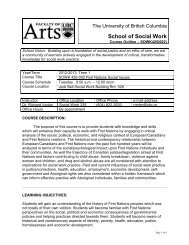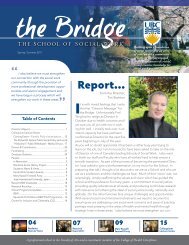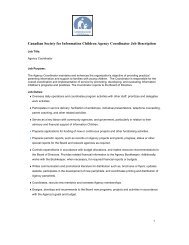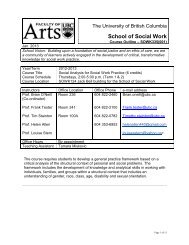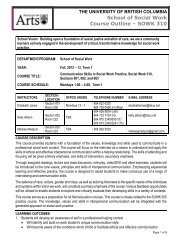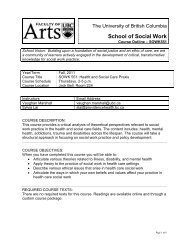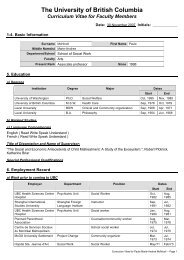Equity Case Studies Report - School of Social Work - University of ...
Equity Case Studies Report - School of Social Work - University of ...
Equity Case Studies Report - School of Social Work - University of ...
Create successful ePaper yourself
Turn your PDF publications into a flip-book with our unique Google optimized e-Paper software.
UBC school <strong>of</strong> social work equity and diversity strategic plan: A compilation <strong>of</strong> case studies 53<br />
Officer, which was a consultant position. The <strong>Equity</strong> Advisor’s role entails participating in the<br />
Diversity Initiative and Committee, outreach, mentoring, and community liaison.<br />
Challenges, Lessons Learned, and Ongoing Goals<br />
As George, Shera, and Tsang (1998) claim, “Organizational change for inclusiveness is<br />
an ongoing, long-term activity. Each stage should proceed from the learning <strong>of</strong> the previous<br />
stage” (p. 82). As such, the Factor Inwentash Faculty <strong>of</strong> <strong>Social</strong> <strong>Work</strong> recognizes the importance<br />
<strong>of</strong> ongoing evaluations, and receiving input from students, faculty, alumni, and community<br />
members. For example, changes in the course on diversity issues, originally called AMNI, were<br />
not made until a comprehensive evaluation was conducted (George, Shera, & Tsang, 1998).<br />
Challenges arose throughout their journey in improving diversity-integration in the curricula,<br />
which propelled the Faculty to continue to work on making improvements. A lesson learned<br />
through this process was the importance <strong>of</strong> evaluations, documentation, and persistence.<br />
Another example <strong>of</strong> their process <strong>of</strong> improving equity and diversity in curricula is the<br />
challenges that ensue in climate when teaching equity-related topics. As George, Shera, and<br />
Tsang (1998) illustrate,<br />
Whereas some students actively demand a training preparing them to work with<br />
diversity, there are different comfort levels in response to diversity issues, especially<br />
when these issues have particular personal significance. For example, students may<br />
position themselves differently in relation to existing and historical social relations <strong>of</strong><br />
oppression and, therefore, have different expectations regarding the political positioning<br />
<strong>of</strong> faculty members and the material they deliver in class. The possible reproduction <strong>of</strong>



